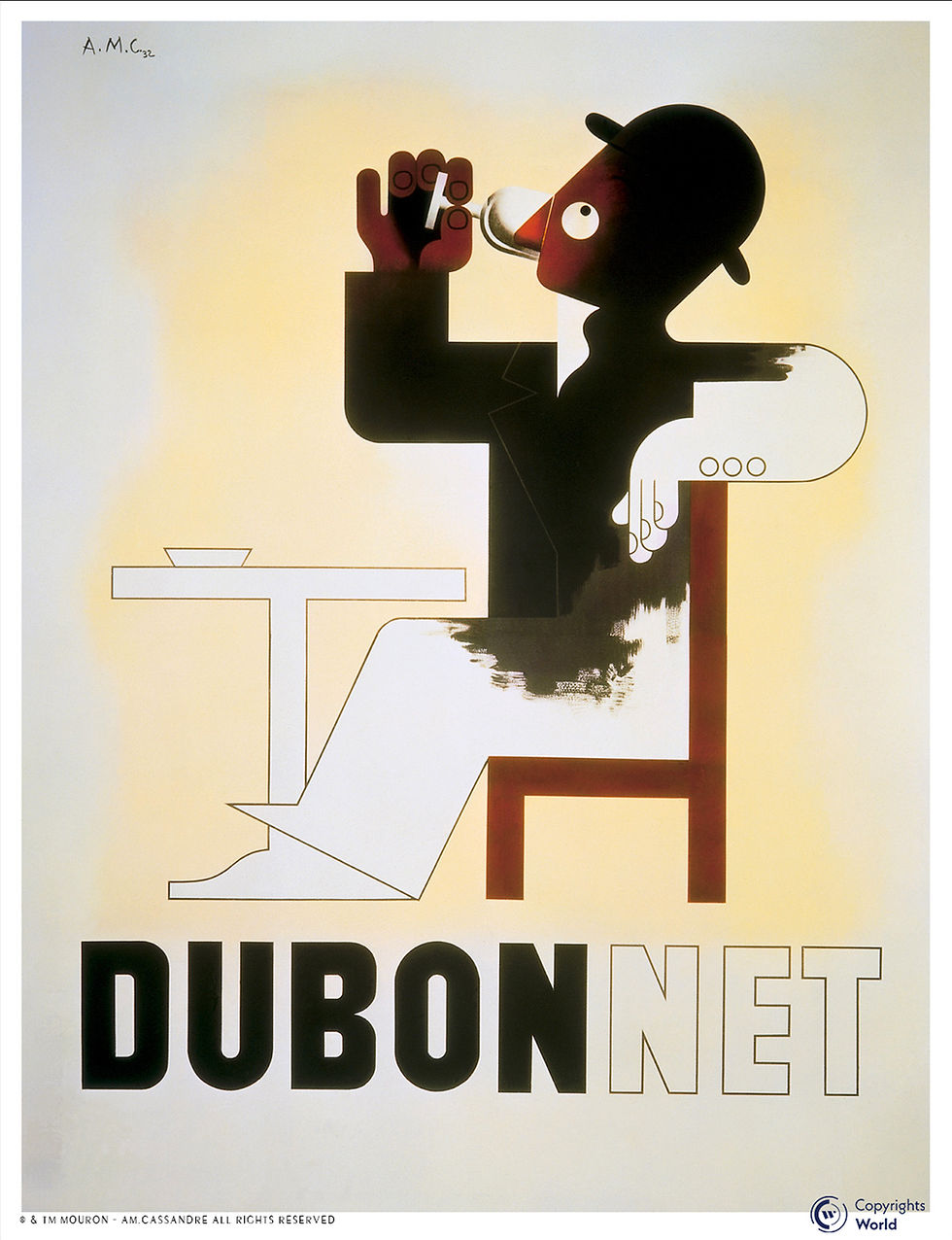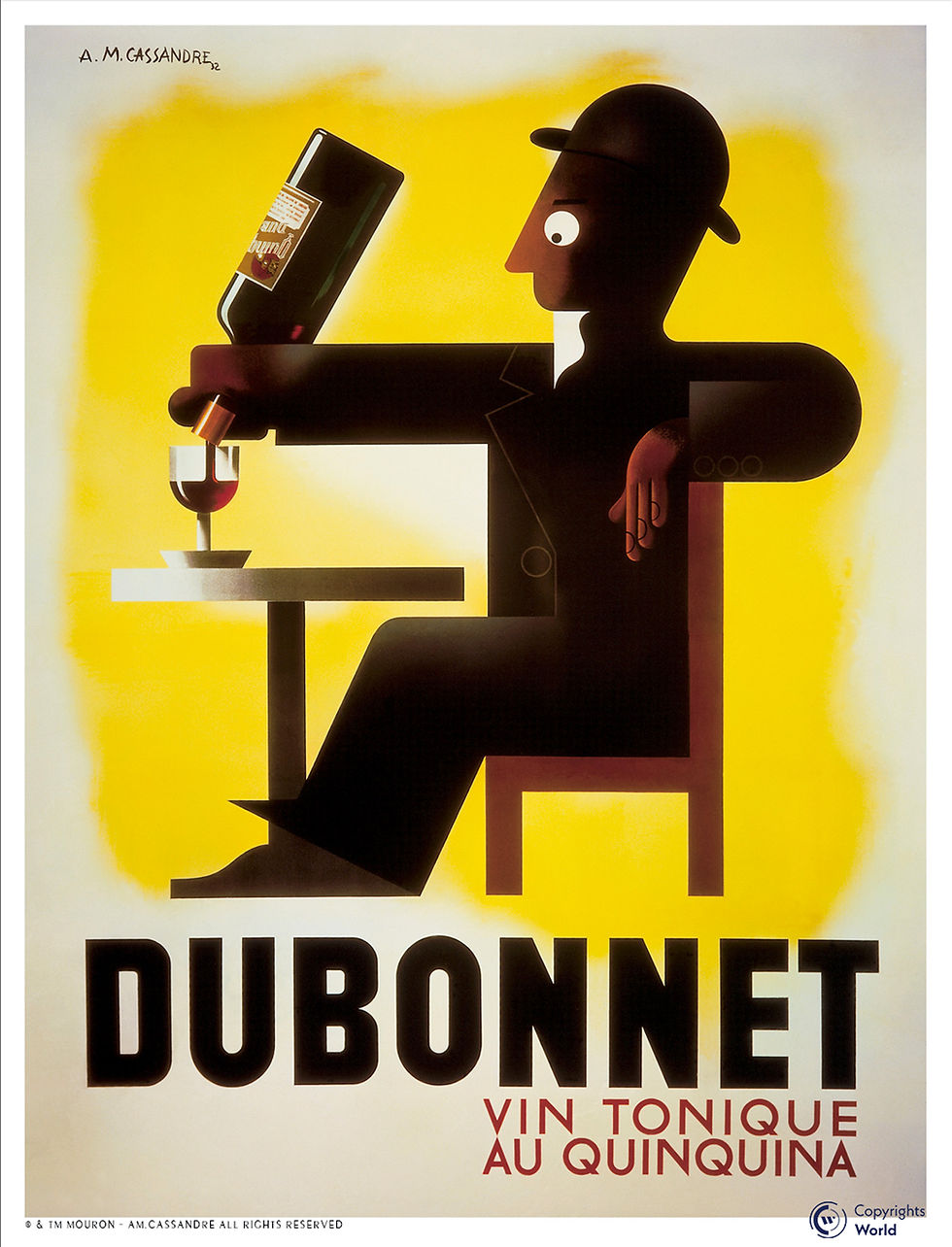FROM DUBONNET TO NETFLIX : Cassandre, Pioneer of Visual Storytelling
- ROLAND MOURON

- 30 juin
- 3 min de lecture
Dernière mise à jour : 9 juil.
When an Aperitif Prefigured Netflix's Codes
What if the first hit series wasn't on a streaming platform, but on the walls of Paris in 1932?
Through his celebrated trilogy of posters for Dubonnet, the master of modern poster art A.M. Cassandre did more than simply promote a tonic wine. He orchestrated a three-act graphic narrative, prefiguring the storytelling mechanisms that govern today's attention economy. Netflix, Amazon Prime, Disney+... all apply today, often unknowingly, the codes established by Cassandre over 90 years ago.

The Graphic Intuition of a Visionary
In three successive visuals published in L'Illustration, Cassandre establishes dramatic tension worthy of a pilot episode:
First, the question: a dark figure sits facing a glass.
Then, experimentation: he tastes, gradually takes on color.
Finally, revelation: transformed, he savors fully.
Here Cassandre establishes a three-part structure that would become a template: initial situation, transformation, resolution. A visual grammar that anticipates, decades ahead, the narrative logic of suspense series and calibrated trailers.
Storytelling in a Split Second
Tell Fast, Strike Hard
Faced with the speed of the urban gaze, Cassandre designs synthetic narration. Each image condenses a stage of the story: approach, action, transformation. This is the ancestor of Netflix thumbnails, which summarize in a fraction of a second a genre, an atmosphere, a promise. DUBO 1932 A.M.CASSANDRE

The Mirror Character
The Dubonnet man is neither a star nor a caricature: he is everyman. This spectator-consumer becomes the actor of his own transformation. Today, recommendation algorithms adopt this principle: "Because you liked...", suggesting that the next content will make us evolve.
The Dramaturgy of Metamorphosis
Color progresses through the Dubonnet character's body as he drinks, like a visual contamination of pleasure. This aesthetic of transformation is now everywhere: animated interfaces, loading bars, transition effects. Example: the opening credits of Stranger Things, where the typography itself distorts to evoke the strange. Cassandre was already there.
From Poster to Modern Teaser
The Art of Visual Promise
The first image of the trilogy is a true teaser. What will happen? The information is partial, suspense is born. This is at the heart of streaming platforms' marketing strategy: distill, suggest, retain. Series like Dark or Westworld distill their imagery, creating narrative tension through information retention. Cassandre was already thinking in terms of "progressive revelation."

Geometric Emotion Cassandre doesn't need expressive lines. He translates emotion through posture, color, composition. A universal language that we find today in digital interfaces, where red signals intensity, blue distance, yellow comedy.

Cassandre, Father of the Visual Algorithm
Personalization Before Its Time
Where Cassandre proposed a universal progression, Netflix declines it infinitely. Yet the objective remains unchanged: guide the gaze toward action, construct a visual narrative path adapted to the viewer.
Condensed Advertising Time
Cassandre invents "short time": the story lasts only a few seconds but produces lasting impact. This is exactly the logic of binge-watching: gratify quickly, then start again.
An Avant-Garde Lesson Still Relevant Today The DUBONNET trilogy, beneath its playful appearance, constitutes a silent revolution. By bringing together graphic design, dramaturgy, psychology of the gaze, and narrative efficiency, Cassandre opens a path that the digital era has merely extended.
Even today, every time a platform seeks to capture our attention, it unconsciously replays the scene imagined by Cassandre: an encounter, a promise, a transformation. The man who raised his glass continues to evolve, this time on our connected screens.
Additional References:
Alain Weill, Cassandre, Éditions Denoël, 1985.
Roland Barthes, Rhetoric of the Image, in Communications, No. 4, 1964.
Marshall McLuhan, Understanding Media, 1968.
Étienne Robial (ed.), Posters and Modernity, Éditions du Centre Pompidou, 1995.
📌 To go further:
Discover the complete history of the Dubonnet poster in our gallery.
Learn more about A.M.Cassandre's life and graphic innovations.
Explore other iconic posters in the original poster gallery.
✍️ Editorial content from cassandre.fr – reproduction prohibited without authorization.

Commentaires